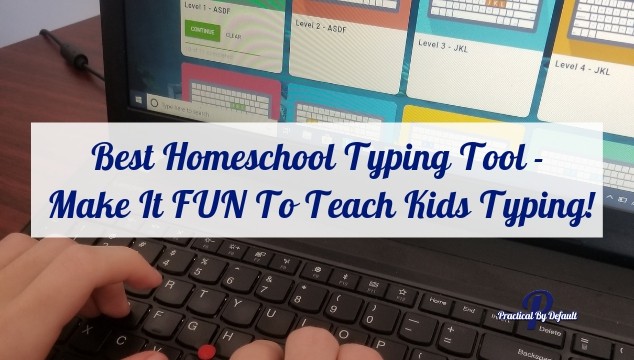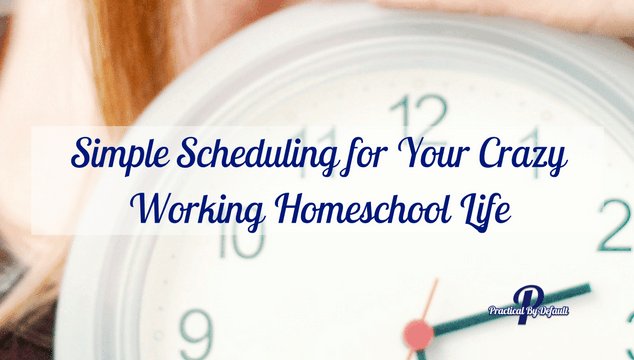5 Easy Steps for Starting Homeschool for Preschoolers
Are you considering starting homeschool for your preschooler but wondering how it fits into your already jam-packed schedule? I completely understand. As a working mom myself, the thought of adding ‘homeschool teacher’ to my ever-growing list of roles was downright intimidating when I first started homeschooling my oldest.
Through my work with numerous dedicated moms in my membership and coaching programs, I’ve gathered a treasure trove of strategies and tips that have proven effective in managing the unique challenges of homeschooling while juggling a career.
This post is packed with those shared experiences, offering practical advice to help you find a balance that comes with starting homeschool for preschoolers that works for your family.
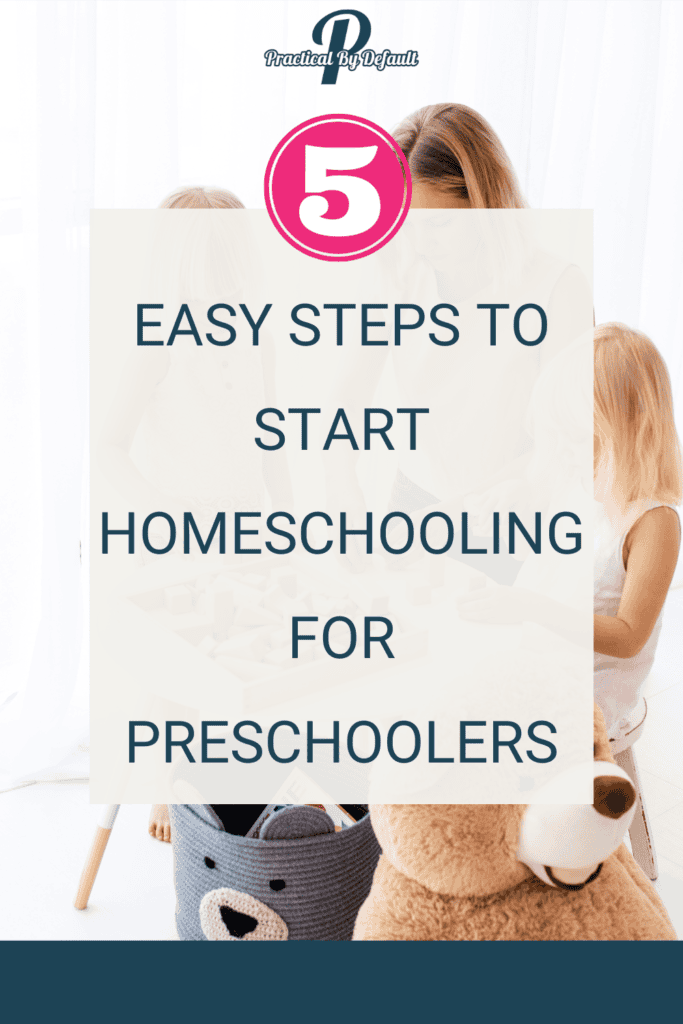
Whether you’re drawn to structured curriculums or freestyle learning through play, you’ll find insights here that empower you to confidently embark on this rewarding journey.
1. Understanding the Basics of Preschool Homeschooling
Starting homeschool for preschoolers can be both an exciting and daunting endeavor, especially for busy working moms trying to fit everything into a 24-hour day. At its core, homeschooling at the preschool level is about nurturing curiosity and fostering a love for learning in a home environment. It’s less about formal lessons and more about learning through play and interaction.
One common misconception is that you don’t need any structured activities at this age—just let them play. While play is indeed critical, integrating some form of structured learning can help your child begin to understand the basics like numbers, letters, and how to interact with the world around them. This doesn’t mean sitting at a desk for hours; rather, it’s about creating opportunities for learning within their play.
For instance, a simple activity like sorting laundry by color involves math, categorization, and color recognition skills—all wrapped up in what many kids see as a fun game. It’s about making the most of these playful moments and turning them into educational experiences, which is perfect for working moms because these activities can often be set up quickly and supervised or revisited throughout the day.
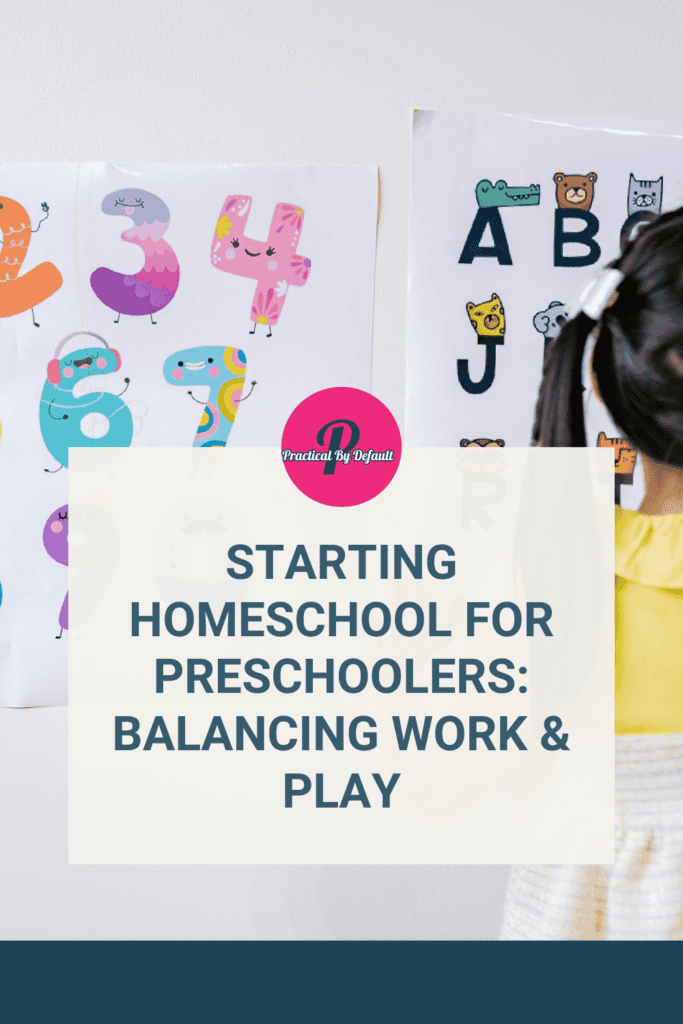
Remember, every child is different, and preschool homeschooling is incredibly flexible. There’s no one-size-fits-all curriculum, and what works for one child may not work for another. Your role is to guide and support your child as they explore and learn at their own pace, ensuring that learning happens in a joyful and low-pressure way.
2. Setting Realistic Goals and Expectations
When starting homeschool for preschoolers, it’s crucial to set realistic goals that align with your family’s lifestyle and your child’s developmental stage.
As great as social media can be, it can also put undue pressure on you and your child. Remember, the primary goal at this age is to foster a love for learning, not to push for academic achievements that are misaligned with their natural growth and curiosity.
Setting Achievable Learning Goals:
When setting goals for your child, you might start with standard Preschool Learning Outcomes, but remember, each child is unique. While my oldest learned to read early, my youngest wasn’t ready at the same age. Initially, I panicked, thinking something was wrong, but it turned out that she just wasn’t ready—and that’s perfectly okay!
Disclosure: I may receive commissions for purchases made through links in this post.
Starting homeschool for preschoolers you’ll want to keep these two things in mind for setting goals:
- Focus on Key Developmental Areas: Concentrate on broad developmental areas such as fine motor skills, language acquisition, basic numeracy, and social skills. For example, a goal can be as simple as your child learning to count to ten or recognizing all the letters in their name.
- Keep Goals Flexible: Be ready to adjust your goals based on your child’s interest and engagement level. If they show more interest in books, incorporate more reading and storytelling into your routine but do not go overboard! Let the child lead.
Embracing Flexibility in Schedules and Outcomes:
- Daily Flexibility: As a working mom, your days might not always go as planned, and that’s okay. Maybe some days, learning happens through a cooking activity in the evening instead of a morning puzzle time. The key is to make learning moments adaptable to your daily realities.
- Long-Term Flexibility: Your child’s preschool years are just the start of their educational journey. If certain skills aren’t mastered this year, there’s always time to develop them. Preschool should be pressure-free, focusing on gradual progress and enjoyment in learning.
By setting realistic and flexible goals, you can create a learning environment that is both supportive and effective, accommodating the unpredictabilities of daily life without compromising on educational quality. This approach not only makes homeschooling more manageable for you but also more enjoyable for your child.
3. Integrating Learning Through Play
Starting homeschool for preschoolers doesn’t require an elaborate classroom setup. In fact, some of the most effective learning happens through play, perfectly suited for busy working moms who need to integrate education into a packed schedule.
Educational Games for Key Skills:
- Counting Fun with Snack Time: Use snacks like pieces of fruit or crackers for simple counting activities. Ask your child to give you a specific number of items, enhancing their numeracy skills while they eat.
- Color Hunt Around the House: Create a game where your child finds objects around the home based on the color you call out. This not only teaches colors but also gets them moving and exploring.
- Word Building with Blocks: If you have letter blocks or magnetic letters, use them to build simple words together. Start with three-letter words to make it enjoyable and stress-free.
Alphabet Puzzle Wooden Puzzles for Toddlers 1 2 3 4 5 Year Old, ABC Puzzle Shape Alphabet Learning Puzzles Toys with Puzzle Board & Letter Blocks, Preschool Educational for Girls Boys

Turning Everyday Activities into Learning Opportunities:
When starting homeschool for preschoolers, don’t forget that everyday activities count as learning, for example:
- Grocery Shopping as a Learning Expedition: Turn a routine trip to the grocery store into a learning experience. Have your preschooler help you find items on your list, identify letters on signs, and count quantities of fruits or vegetables. This can be a fun and engaging way to teach math and reading skills.
- Cooking Together: Involve your child in meal preparation. Cooking involves a range of skills from measuring ingredients (math skills) to following a recipe (reading and sequencing). Describe what you’re doing and ask them to help with tasks appropriate for their age, like stirring or pouring.
By weaving these playful learning activities into your daily routine, you ensure that education becomes a natural part of your child’s day. This approach not only makes learning fun but also fits seamlessly into your busy schedule, making the most of the time you spend together.
4. Choosing the Right Resources For Preschool
For many moms starting homeschool for preschoolers, using a structured curriculum can provide a clear pathway for daily activities and educational goals. If you prefer having a more organized approach, choosing the right curriculum is crucial to align with your child’s learning style and your family’s unique schedule.
How to Choose a Preschool Curriculum:
- Assess Learning Styles: Observe how your child learns best. Do they enjoy stories and visual presentations, or do they prefer hands-on activities? Select a curriculum that incorporates these elements to keep them engaged and eager to learn.
- Consider Your Schedule: Look for a curriculum that fits well with your working hours and other commitments. Many programs designed for homeschoolers are incredibly flexible, allowing you to adapt lessons to fit shorter or more irregular timeslots.
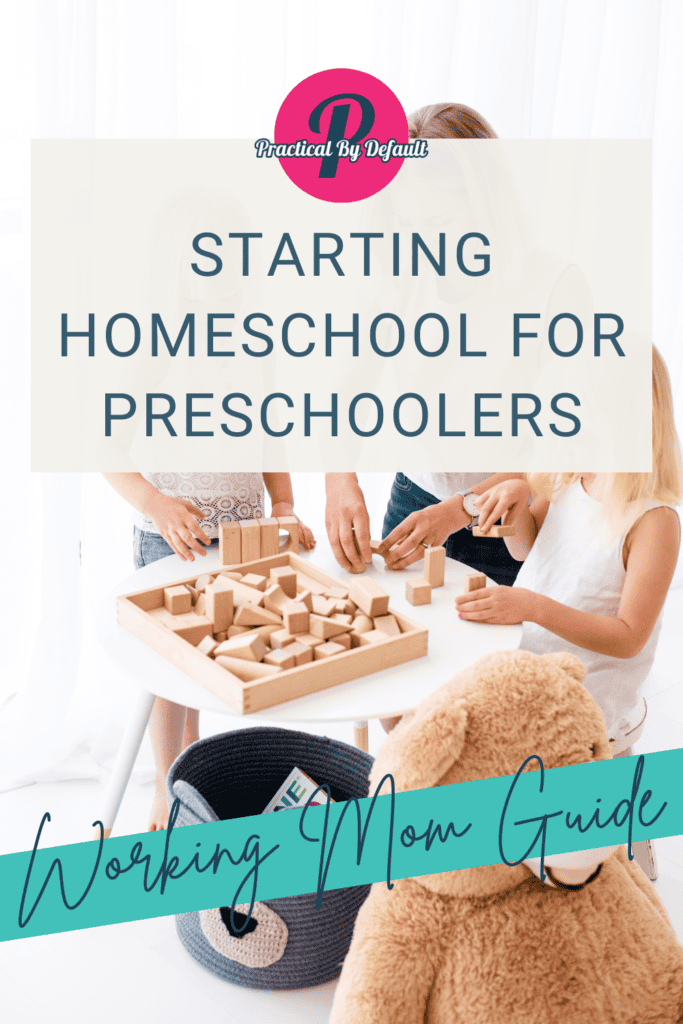
Recommended Flexible and Mom-Approved Curriculums:
I preferred to use a program as an outline with my littles, here are a few for you to try:
- ABC Mouse: This online platform is praised for its interactive and engaging activities that cover a wide range of subjects suitable for preschoolers. It’s designed to be flexible, allowing children to learn at their own pace.
- Time4Learning: This curriculum offers a comprehensive educational experience with activities designed to be fun and engaging, making learning feel like play. It’s also easy to customize around different schedules, which is ideal for busy families.
- Montessori at Home E-books: For those interested in a more hands-on, child-led learning approach, Montessori at Home provides resources and guides to help you set up a Montessori environment in your own home. These resources are great for encouraging independence and practical life skills.
Montessori from the Start: The Child at Home, from Birth to Age Three


Choosing the right resources will not only make your homeschooling journey more structured but also more enjoyable and effective. When starting homeschool for preschoolers, consider a curriculum that fits your lifestyle and your child’s needs, you create a learning environment where preschool education becomes a delightful part of your daily interaction.
5. Organizing Your Day Effectively
Balancing work, homeschooling, and personal time may seem daunting, but with some strategic planning, it’s entirely feasible.
Here are practical tips and a sample daily schedule that can help you manage your day effectively, ensuring you meet your professional obligations while providing a meaningful educational experience for your preschooler.
Practical Time Management Tips:
Time management for busy moms is essential when it comes to figuring out when and what your homeschool will look like for your family. Here are a few things to consider:
- Set Priorities: Begin by defining what’s most important each day—for both work and homeschooling. Some tasks will be high priority and others can wait. Recognize that not everything has to be perfect.
- Use Time Blocks: Allocate specific times for work, teaching, and personal time. This method helps you stay focused on one area without feeling overwhelmed by another. For instance, you might set aside morning hours for work tasks when your child is most engaged in independent play.
- Prepare in Advance: Spend some time each evening planning the next day’s learning activities. Simple, prepared activities can save you time and keep your child engaged while you work.
Sample Daily Schedule for a Working Homeschool Mom:
I don’t know about you, but sometimes I just need to see an idea of what starting homeschool for preschoolers schedule might look like, so I am sharing one with you below.
Grab these free printable planning pages and create your own schedule for homeschooling preschool!
- 7:00 AM – 8:00 AM: Morning routine and breakfast together
- 8:00 AM – 10:00 AM: Child engages in independent play with educational toys while you tackle the most pressing work tasks
- 10:00 AM – 11:00 AM: Interactive learning session (this could be a mix of guided play, reading, or using a preschool curriculum)
- 11:00 AM – 12:00 PM: Outdoor play or a walk, which can be both relaxing and stimulating for the child
- 12:00 PM – 1:00 PM: Lunch and some downtime for both of you
- 1:00 PM – 3:00 PM: Naptime for the child which can be your key work time
- 3:00 PM – 4:00 PM: Second learning session focusing on creative arts or science activities that are more hands-on
- 4:00 PM – 5:00 PM: Free play while you wrap up the day’s work
- 5:00 PM onwards: Family time, dinner, and preparing for the next day
This schedule is just a template and can be adjusted based on your work requirements and your child’s needs. The idea is to create a rhythm that allows for flexibility but also gives structure to both your and your child’s day.
Starting Homeschool for Preschoolers Made Easy
Starting homeschool for preschoolers is a journey that brings learning and growing together. This blog post has outlined practical steps and strategies to make this process enjoyable and feasible, even amidst a busy schedule.
- Spring Flowers Books & Activities for Preschoolers
- 16 Of The BEST Educational Apps For Little Kids
- Little Animals Spring Theme That Will Delight Your Preschoolers
Remember, every moment spent educating your child is an opportunity for both of you to learn and bond. Embrace starting homeschool for preschoolers with the flexibility and cherish each step of this educational path. You’re not just teaching; you’re creating lasting memories.
📌Don’t let this post get lost in the internet abyss – pin it to your Pinterest board now!
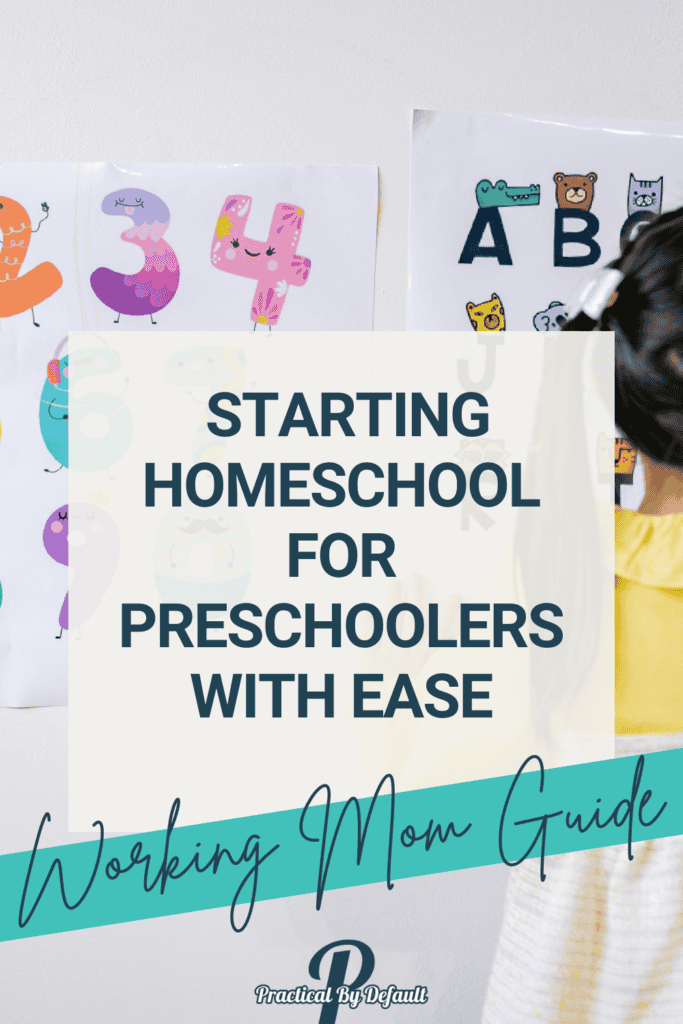

Hi, I’m Jen. I help working moms juggle their career and homeschool their kids by providing support, systems and tools. You are warmly invited to Join the Online Community Here!











